1.Introduction
Advertising plays a crucial role in generating product awareness among potential consumers and influencing their purchasing decisions [1]. Marketers have access to various mass-communication tools such as advertising, sales promotion, and public relations [1]. While advertising across different mediums has an impact on audiences, television stands out as a particularly powerful medium due to its extensive reach [2]. Television advertising has the potential to shape not only an individual's attitude, behavior, lifestyle, and exposure but also, over time, even the culture of a country [2].
Research on advertisements’ impact on consumers’ behavior has a long tradition. In the past few decades, not only economists but also students of advertising have done a lot of researches. However, the author finds that there are few evidence for what consumers really think about video advertisements. The author thinks that only by knowing consumers’ thoughts can the advertising industry improve and develop. Many studies failed to find what kind of planted video advertisement is the most welcome and has the most effective impact. In order to supply some of the gaps in those literatures, the author investigates and uses the method of cross-over analysis to tap more reasons behind those phenomena.
2.Method
2.1.Research Objects
The target population of the author’s questionnaire is people of all ages. Because of the popularity of online TV series, not only people of specific age are able to watch online TV series. Hence, the author can compare people’s age with whether they are economically independent to analyze the data of the questionnaire more effectively.
2.2.Questionnaire Design
The questionnaire is divided into 3 parts. The first part of which is basic personal information including gender, age, and source of income. The second part is the main part of the questionnaire which concludes: if people have bought any product from different kinds of advertisements when and after they finished watching TV series, their attitudes towards the TV advertisements, when they will buy those products immediately, the brand that appeared in TV series which impress them deeply. The last part of the questionnaire is asking about the investigated people’s three strongest pieces of advices for advertisement in TV series.
2.3.Research Procedure
The author uses Photoshop software to combine the QR code with an eye-catching picture to arouse people’s interest. The author first gave out the questionnaire link and QR code through WeChat moment and several group chats, hoping can get valuable data from the author’s trustful friends. However, the author found that the data were not enough to analyze. Hence, the author asked parents for help to send out the link to their reliable colleagues, friends, and relatives. To avoid useless questionnaires, the author wrote a short paragraph as the introduction part of the questionnaire, so that the investigated people can know the importance of asking questions carefully and honestly. Finally, the questionnaire lasted for 3 days, and the author received 74 responses, with 74 effective results for every question.
The participants’ genders, ages, and salary sources that whether they are economically independent or not could demonstrate a basic user portrait. This enables the author to find the relationship between personal information and the results of the following questions. After that, the questions which ask for the participants’ experience of buying products are aimed to get people’s historical behaviors. Additionally, the author also asks about the participants’ attitudes towards advertisements in TV series and sets several possible reasons for them to choose. By combining these reasons with the following questions about the impressive brands and people’s top three suggestions for advertisement in TV series, the author wants to depict a possible better vision of the future. All in all, the author hopes she can tap more potential of advertisement in marketing through all these questions.
3.Results
3.1.Economically Independent Participants Have Stronger Purchasing Power
The author marked “yes” for the result of all the questions about whether the participants having bought products through four kinds of advertisement in TV series as one mark. Higher scores mean stronger purchasing ability. As Figure 1 shows, the vertical axis means the percentage of participants who have bought different number of types of ads. The horizontal axis shows the number of types of ads participants have purchased among properties, pop up, scene play and interstitial. As Figure 1 shows, the author finds that people who are economically independent have stronger purchasing power comparing to those participants who are still economically dependent. This result can be strongly proved especially in the section of scene play and interstitial advertisement.
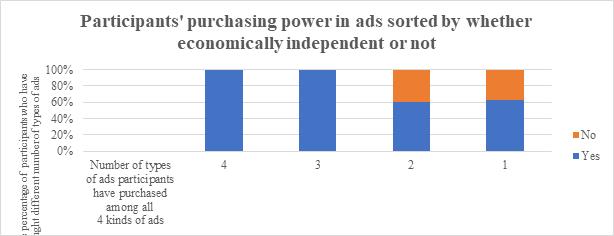
Figure 1: Participants’ purchasing power in ads sorted by whether economically independent or not.
3.2.Advertisements Placed as Properties Have the Strongest Attraction and Effect
For both groups of people, they tend to buy products shown in the way of properties in TV series. 90 percent of economically dependent participants and 100 percent of economically independent ones who have bought products through advertisement have bought those advertisement placed as properties (see Figure 2). Even among those who have never bought products, properties advertisement leaves the best impression to them, which accounts for 100 percent (see Figure 3). All participants answer this question prefer those food advertisement placed as properties in TV series. By the way, 46 percent of people think that they will buy products shown as properties at once if they are interested by the plot of TV series.

Figure 2: Participants’ experience of having bought products in ads sorted by income resource.
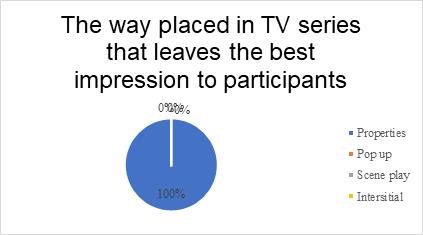
Figure 3: The way placed in TV series that leaves the best impression to participants.
3.3.People Do Not Like Advertisements Placed as Pop-up
Both economically independent participants and dependent ones rarely buy products in advertisements through the way of pop up. In the questionnaire, participants can choose more than one of those four types of ads that they have bought before so the total percentage is more than 100 percent. As Figure 4 and Figure 5 show, only 10 percent of economically independent participants while even zero economically dependent people have bought pop-up products in TV series’ advertisement (see Figure 5). The author deduces that pop up advertisements can catch the least attraction of the audience.
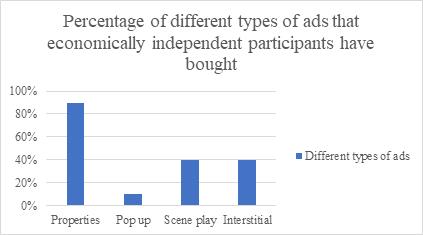
Figure 4: Percentage of different types of ads that economically independent participants have bought.

Figure 5: Percentage of different types of ads that economically dependent participants have bought.
3.4.Most People Hold Negative View Towards Advertisements in TV Series
The result of the question about people’s viewpoints towards advertisement TV series shows that three quarters of people tend to hold negative view (see Figure 6).
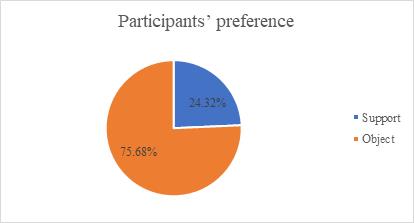
Figure 6: Participants’ preference.
3.5.Reasons Why Participants Object or Support Advertisements in TV Series
Among the participants who hold negative view towards advertisement in TV series, the majority think that advertisements interrupt their process of watching videos. The second highest supported reason is advertisements are repeated too much, which causes the audiences’ aesthetic fatigue. Another reason is people consider that those advertisement are not relevant to the storyline, which seems to be isolated from TV series. All these data are shown in Figure 7.

Figure 7: The reason why participants object ads in TV series.
However, there are still 25% participants who support TV advertisement. As Figure 8 shows, among this minor group of people, 50 percent of them think that most of those advertisements are interesting and can provide them some time to relax and this period of time is still talking something based on the content of TV series. At the same time, 50 percent people deem that they can know more products through advertisements to keep up with the times. Besides, the author analyzes separate these people into two group by gender. The author find that females tend to support those advertisement because of interests towards TV series, however, males tend to support due to the need of knowing more about new products themselves.
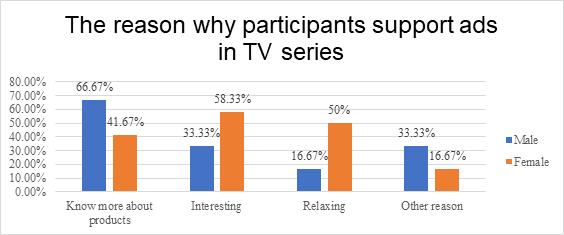
Figure 8: The reason why participants support ads in TV series.
3.6.The Preferences of Advertisements in TV Series Sorted by Different Factors
Also, as Figure 9 shows, on one hand, the author deduces that participants’ emotional tendency is irrelevant to their gender since the preference percentage are almost equal to each other. As Figure 10 shows, on the other hand, the author finds that people below 18 years old and people whose ages range from 30 to 39 years old have the most significant difference in preference for TV series’ advertisement. Only about 12 percent of teenagers below 18 years old support those advertisement, while the proportion of support and objection among people from 30 to 39 years old is half and half.
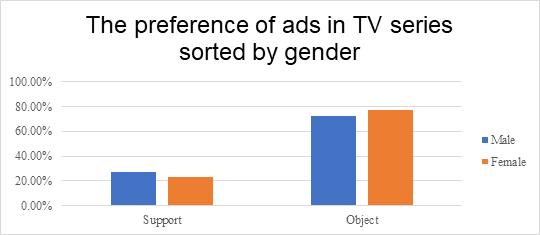
Figure 9: The preference of ads in TV series sorted by gender.
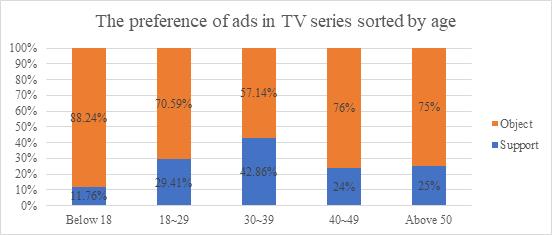
Figure 10: The preference of ads in TV series sorted by age.
4.Discussion
After analyzing data and getting results, the author finds reasons behind those results.
Firstly, economically independent people have stronger purchasing power because they can freely control how to use their money, which is quite obvious.
Secondly, advertisements placed as properties have the strongest attraction and effect. According to Forster’s study in 1984, the subliminal stimulates the effects of advertisements are classified into short-term and long-term. Most importantly, those long-term effects were mostly mediated by textual plot elements [3]. Hence, the effectiveness of planted advertisements in TV series is based on how closely they are connected with plot, especially in narrative plot [4]. When consumers actively seek connections between advertising and the context, they engage in content interaction [5]. Since properties are always relevant to the plot’s content, they can definitely impress consumers very well.
Thirdly, people do not like advertisements placed as pop-up. According to the conclusion of reason of participants’ objection to ads in TV series, people dislike those advertisement which interrupt them. Pop-up advertisements usually appear when consumers pause the video. Unlike video advertising, this type of advertising is static, so it needs to focus on all the content it wants to promote in one image. There is no denying that one of the dilemmas designers face these days is the irreconcilable conflict between the amount of information the advertiser wants to convey and the artistic design [6]. Pop-up advertisements always occupy many spaces of the screen. Either typography or images are easily to be unstructured [6]. Consumers are likely to feel those elements are crowded [6]. As advertiser's primary mission is to reach potential customers and influence their awareness, attitudes and buying behavior [7, 8]. Therefore, the elements are unable to affect consumers in a positive physiological way. Emotional advertising is widely regarded as one of the most effective techniques, so that consumer ultimately gives emotional response to that product [9].
Fourthly, most people hold negative view towards advertisements in TV series. According to Iqiyi’s financial statement, other revenue experienced significant growth. However, advertising revenue has consistently declined since 2018 [10]. This decline can be attributed to intensified competition in the online video industry, the emergence of the short-form video sector in the region, the increased availability of advertising platforms for third-party services, and a lack of substantial growth in demand for third-party advertisements [10]. As can be seen, the ubiquitous and overwhelming large amount of advertisements have diminished consumers' inclination to buy products and have adversely affected the advertising industry.
Fifthly, among those participants support advertisements in TV series, male focus more on products themselves while female focus more on their feeling. Research shows that female consumers find it more difficult to achieve emotional satisfaction, while males find online shopping more practical and convenient [11]. In terms of physiology, the differences in the organisation of the cerebral cortex between males and females lead to differences in the processing of information between males and females [11]. Consequently, their advertising needs differ. Males exhibit greater interest in the practical aspect of rationality, whereas females demonstrate a stronger inclination towards the enjoyable and emotional aspect.
Sixthly, people below 18 years old and people whose ages range from 30 to 39 years old have the most significant difference in preference for TV series’ advertisement. The author thinks it’s also because of their income resources are completely different. According to the research of online shopper in Malaysia, the online shopper, while on the age group, 38% of respondents are in between 31 and 40, compared to 29. 8% from age between 18 to 30, and 32. 8% from age at 41 and above [12]. One possible interpretation is that the age group with the highest percentage consists of working adults who have higher incomes and fewer commitments but are busy with their schedules. Consequently, this encourages them to make more online purchases of products [12].
Seventhly, due to participants’ suggestions written in the questionnaire, as Figure 11 shows, the author suggests that the companies should reduce the duration and repetition rate of their ads appropriately to avoid boring consumers and reducing the desire to buy instead. The companies should also be more precise in their placement and enhance the relevance of the product to the episode. In addition, video companies should design computer programs to allow for a greater variety of ads.

Figure 11: Suggestions from participants.
5.Conclusion
In this paper, the author shows that people’s viewpoints and preferences towards different advertisements in TV series vary from person to person due to many different factors. These factors include income resource, gender, and age. Results indicate that most people dislike advertisements in TV series because of the interruption. Hence, pop-up advertisements naturally turn out to be the most unwelcome way among common ways that advertisements planted in TV series.
Also, there are some discoveries revealed by these data, there are also some limitations. First, there are only 74 effective results, so the sample size is not big enough. Second, the ratio of male and female is not balanced. Among all the results, 70. 27% are females and only 29. 73% are males. There are much more females than males among all participants. Third, some of the references are papers written in Chinese so there may exists some inaccuracy in translation. This research is only a sampling survey. Thus, the results do not imply the consumer image of whole society.
However, these problems could be solved if the companies invest in supporting wider social research and conducting accurate analysis, they could get a more complete image of their consumers. This seeming to be low return on investment, nevertheless, it actually contributes to the long-term development of the whole advertising industry. The adverting companies will also benefit a lot from tapping their potential users.
In summary, the author identifies some factors influencing people’s viewpoints and people’s preferences towards advertisements in TV series. Alternatively, the author gives some advice to the advertising industry and she hopes that there will be more advertisements of high quality in TV series. The author also mentions some possible ways for those companies to further her research findings.
References
[1]. Saleem, S. & Abideen, Z (ZOI. Citecuve advertising and its intluence on consumer buying behavior. European Joumal of Business and Management. 3(3). 55-67.
[2]. Abideen, Zain Ol. & Latt. Abdul. Do Brand Extensions Affect Consumer Attitude: An Empirical Experience- With Reference to Pakistani Consumers. The Journal of Applied Business Research, 27(2), March/April 2011, pp. 19-36.
[3]. Forster KI, Davis C (1984), Repetition priming and frequency attenuation in lexical access. J Exp Psychol Learn Mem Cognit 10, p680-698.
[4]. Jie Du. (2022). Content Construction and Path Selection of Subliminal Advertising (master’s Thesis, InnerMongoliaUniversity). https://kns. cnki. net/KCMS/detail/detail. aspx?dbname=CMFD202301&filename==1022631189. nh
[5]. Liu, L., & Chen, H. (2019). Balancing impressiveness and favorability: A qualitative study on an emerging type of advertising in China. Global Media and China, 4(4), 477-492.
[6]. Wenjing Min. (2017). Study on the Visual Performance of Online Video Pause Advertising (master’s thesis, HubeiUniversityofTechnology). https://kns. cnki. net/KCMS/detail/detail. aspx?dbname=CMFD201702&filename=1017815764. h
[7]. Adeolu B. Ayanwale, Taiwo Alimi and Matthew A. Ayanbimipe (2005). The Influence of Advertising on Consumer Brand Preterence. Joumal ot Social Sciences, 1007 9-10.
[8]. Adelaar, T., Chang, S., Lanchndorfer, K. M., Lec B. & Morimoto M. (2003). Effects of Media Formats on Emotions & Impulse Buying Behavior. Joumal of Information Technology, 18, 247-266.
[9]. rassington, F. & Pettitt, S. (2001). Principles of Marketing, 3rd Edition, Pearson Education, Frentice hall.
[10]. Mudi Liu. (2022). Study on the Implantable Advertisement of Igiyi's "Misty Theater" (Master's thesis, Henan UniversityofTechnology)https://kns. cnki. net/KCMS/detail/detail. aspx?dbname=CMFDTEMP&filename=1023456834. n
[11]. Yuging Zhao. (2018). Gender Differences in Consumer Decision-Making Processes during Online Shopping Festivals (Master's thesis, Dalian University of Technology) httos://kns. cnki. net/KCMS/detail/detail. asox?dbname=CMFD201901&filename=1018868713. nh
[12]. Wai, K., Dastane, D. O., Johari, Z., & Ismail, N. B. (2019). Perceived risk factors affecting consumers online shopping behaviour. The Journal of Asian Finance, Economics and Business, 64), 246-260.
Cite this article
Hu,H. (2023). Factors Influence People’s Viewpoints and Preferences towards Advertisements in TV Series. Communications in Humanities Research,10,141-150.
Data availability
The datasets used and/or analyzed during the current study will be available from the authors upon reasonable request.
Disclaimer/Publisher's Note
The statements, opinions and data contained in all publications are solely those of the individual author(s) and contributor(s) and not of EWA Publishing and/or the editor(s). EWA Publishing and/or the editor(s) disclaim responsibility for any injury to people or property resulting from any ideas, methods, instructions or products referred to in the content.
About volume
Volume title: Proceedings of the 4th International Conference on Educational Innovation and Philosophical Inquiries
© 2024 by the author(s). Licensee EWA Publishing, Oxford, UK. This article is an open access article distributed under the terms and
conditions of the Creative Commons Attribution (CC BY) license. Authors who
publish this series agree to the following terms:
1. Authors retain copyright and grant the series right of first publication with the work simultaneously licensed under a Creative Commons
Attribution License that allows others to share the work with an acknowledgment of the work's authorship and initial publication in this
series.
2. Authors are able to enter into separate, additional contractual arrangements for the non-exclusive distribution of the series's published
version of the work (e.g., post it to an institutional repository or publish it in a book), with an acknowledgment of its initial
publication in this series.
3. Authors are permitted and encouraged to post their work online (e.g., in institutional repositories or on their website) prior to and
during the submission process, as it can lead to productive exchanges, as well as earlier and greater citation of published work (See
Open access policy for details).
References
[1]. Saleem, S. & Abideen, Z (ZOI. Citecuve advertising and its intluence on consumer buying behavior. European Joumal of Business and Management. 3(3). 55-67.
[2]. Abideen, Zain Ol. & Latt. Abdul. Do Brand Extensions Affect Consumer Attitude: An Empirical Experience- With Reference to Pakistani Consumers. The Journal of Applied Business Research, 27(2), March/April 2011, pp. 19-36.
[3]. Forster KI, Davis C (1984), Repetition priming and frequency attenuation in lexical access. J Exp Psychol Learn Mem Cognit 10, p680-698.
[4]. Jie Du. (2022). Content Construction and Path Selection of Subliminal Advertising (master’s Thesis, InnerMongoliaUniversity). https://kns. cnki. net/KCMS/detail/detail. aspx?dbname=CMFD202301&filename==1022631189. nh
[5]. Liu, L., & Chen, H. (2019). Balancing impressiveness and favorability: A qualitative study on an emerging type of advertising in China. Global Media and China, 4(4), 477-492.
[6]. Wenjing Min. (2017). Study on the Visual Performance of Online Video Pause Advertising (master’s thesis, HubeiUniversityofTechnology). https://kns. cnki. net/KCMS/detail/detail. aspx?dbname=CMFD201702&filename=1017815764. h
[7]. Adeolu B. Ayanwale, Taiwo Alimi and Matthew A. Ayanbimipe (2005). The Influence of Advertising on Consumer Brand Preterence. Joumal ot Social Sciences, 1007 9-10.
[8]. Adelaar, T., Chang, S., Lanchndorfer, K. M., Lec B. & Morimoto M. (2003). Effects of Media Formats on Emotions & Impulse Buying Behavior. Joumal of Information Technology, 18, 247-266.
[9]. rassington, F. & Pettitt, S. (2001). Principles of Marketing, 3rd Edition, Pearson Education, Frentice hall.
[10]. Mudi Liu. (2022). Study on the Implantable Advertisement of Igiyi's "Misty Theater" (Master's thesis, Henan UniversityofTechnology)https://kns. cnki. net/KCMS/detail/detail. aspx?dbname=CMFDTEMP&filename=1023456834. n
[11]. Yuging Zhao. (2018). Gender Differences in Consumer Decision-Making Processes during Online Shopping Festivals (Master's thesis, Dalian University of Technology) httos://kns. cnki. net/KCMS/detail/detail. asox?dbname=CMFD201901&filename=1018868713. nh
[12]. Wai, K., Dastane, D. O., Johari, Z., & Ismail, N. B. (2019). Perceived risk factors affecting consumers online shopping behaviour. The Journal of Asian Finance, Economics and Business, 64), 246-260.









